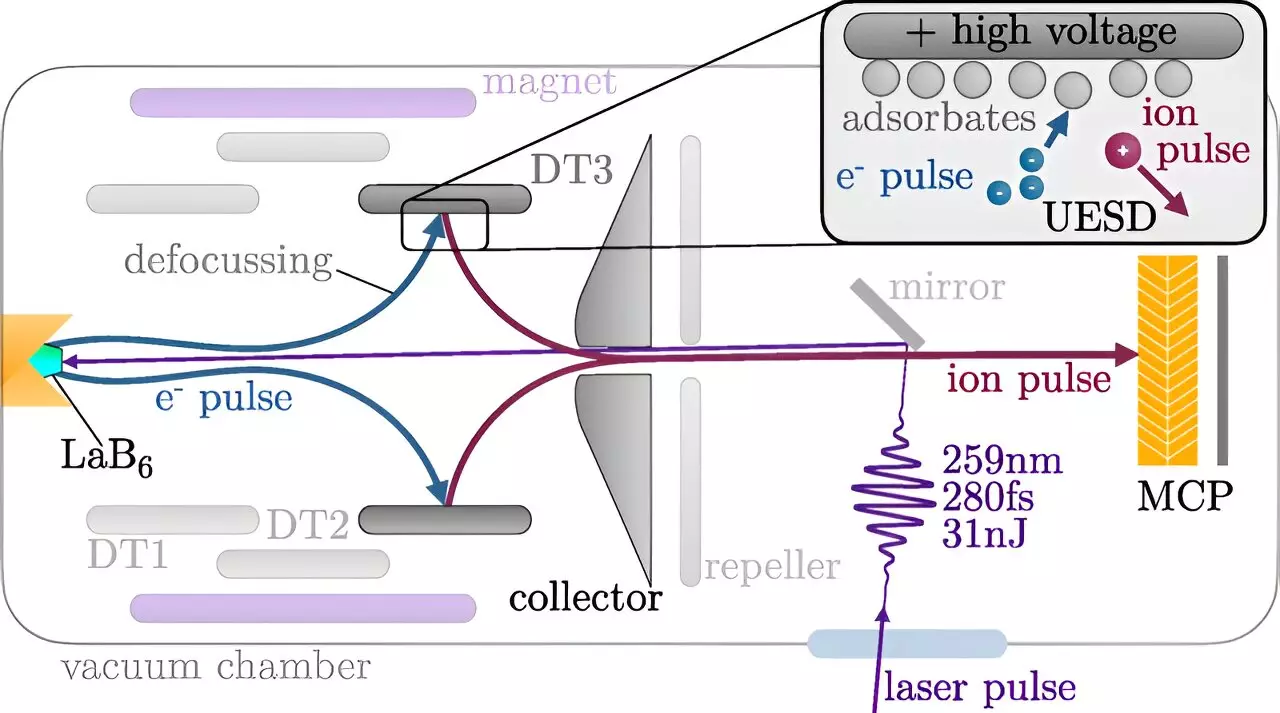At the forefront of modern physics, researchers at TU Wien in Vienna have achieved a remarkable milestone: the generation of laser-synchronized ion pulses having a duration of less than 500 picoseconds. This innovative technique opens new avenues for observing rapid chemical processes occurring on material surfaces, which can significantly advance our understanding of chemical reactions in real-time. By combining traditional ion beam methodologies with cutting-edge laser technology, the team has pushed the boundaries of experimental physics, as reported in their latest publication in *Physical Review Research*.
The need for precision timing is critical in experimental physics, particularly when attempting to probe fast-moving phenomena. To articulate this principle, one may liken it to capturing high-speed photographs; a camera with a very short exposure time is essential to freezing motion. Similarly, in the realm of atomic and molecular interactions, shorter laser pulses are traditionally utilized to capture the fast-paced processes happening on the subatomic level. The latest research underscores how ion pulses can complement and enhance our ability to visualize these fleeting moments, particularly on material surfaces where many chemical reactions transpire.
Historically, ion beams have found various applications, including material analysis and surface modification. Yet, these traditional approaches have primarily focused on the end products of these interactions, rather than the dynamic processes that lead to those outcomes. Professor Richard Wilhelm from the Institute of Applied Physics at TU Wien acknowledges this limitation, pointing out that generating sufficiently short ion pulses for real-time analysis has been a technological hurdle. The breakthrough achieved by his team now allows scientists to observe the intricate temporal course of ion interactions, rather than just the final result.
Understanding the Timescale of Ion Pulses
The ion pulses developed at TU Wien exist in an extraordinarily brief timeframe, lasting less than 500 picoseconds—an epoch eclipsed by everyday experience, as this duration is just a fraction in the grand spectrum of time. To put this into perspective, light travels only around 15 centimeters in that timeframe. While the interval is significantly longer than the cutting-edge attosecond laser pulses, it is well-optimized for surfacing analysis, perfectly bridging the gap between faster-than-light phenomena and accessible observation techniques.
The research team had to devise a novel multi-stage process to generate these high-intensity ion pulses. Initially, a laser pulse is directed at a cathode, triggering the emission of electrons. These accelerated electrons then strike a stainless steel target, leading to the release of atoms—including key elements like hydrogen and oxygen—that are typically present on the target surface. The ensuing collisions lead to the ejection of electrically neutral and ionized atoms, allowing for a refined selection process where electric fields can direct the desired atoms as precise ion pulses toward the target surface.
The true promise of these short ion pulses lies in their application during ongoing chemical reactions. Through time-controlled probing, the researchers can send ion pulses at various stages of reactions initiated by lasers. This innovative methodology offers a window into the mechanistic processes that unfold in real time, enabling researchers to discern how different variables influence various reactions on a picosecond scale.
Future Prospects and Developments
Currently, the technique focuses on generating protons as the simplest ions. However, the potential exists for the same methodology to be expanded to include the generation of more complex ions, such as carbon or oxygen ions. This versatility stems from the ability to tailor the coating applied to the stainless steel target, thereby modifying which atoms are liberated during the process. Future plans include refining the ion pulses to even shorter durations through the application of specialized alternating electromagnetic fields to control the velocities of ions in the pulse.
The research conducted at TU Wien not only represents a significant advancement in the realm of ultrafast science but also lays the groundwork for more sophisticated techniques capable of investigating phenomena that previously eluded detailed examination. By integrating these newly developed ion pulse generation methods with existing ultrafast electron microscopy technologies, researchers can expect to peel back layers of complexity in surface chemistry and physics, potentially revolutionizing our insights into the atomic and molecular worlds. As science seeks to understand the minute intricacies of chemical interactions, such innovations may play a pivotal role in material science, catalysis, and beyond.


Leave a Reply